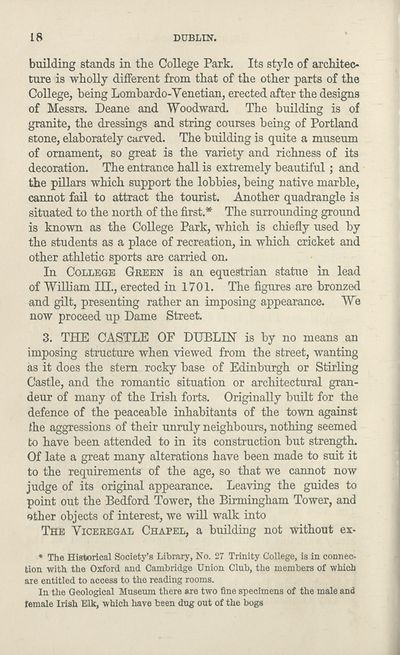Download files
Complete book:
Individual page:
Thumbnail gallery: Grid view | List view

18
DUBLIN.
building stands in the College Park. Its style of architec¬
ture is wholly different from that of the other parts of the
College, being Lombardo-Yenetian, erected after the designs
of Messrs. Deane and Woodward. The building is of
granite, the dressings and string courses being of Portland
stone, elaborately carved. The building is quite a museum
of ornament, so great is the variety and richness of its
decoration. The entrance hall is extremely beautiful; and
the pillars which support the lobbies, being native marble,
cannot fail to attract the tourist. Another quadrangle is
situated to the north of the first.* The surrounding ground
is known as the College Park, which is chiefly used by
the students as a place of recreation, in which cricket and
other athletic sports are carried on.
In College Green is an equestrian statue in lead
of William III., erected in 1701. The figures are bronzed
and gilt, presenting rather an imposing appearance. We
now proceed up Dame Street.
3. THE CASTLE OF DUBLIN is by no means an
imposing structure when viewed from the street, wanting
as it does the stem rocky base of Edinburgh or Stirling
Castle, and the romantic situation or architectural gran¬
deur of many of the Irish forts. Originally built for the
defence of the peaceable inhabitants of the town against
the aggressions of their unruly neighbours, nothing seemed
to have been attended to in its construction but strength.
Of late a great many alterations have been made to suit it
to the requirements of the age, so that we cannot now
judge of its original appearance. Leaving the guides to
point out the Bedford Tower, the Birmingham Tower, and
other objects of interest, we will walk into
The Viceregal Chapel, a building not without ex-
* The Historical Society’s Library, No. 27 Trinity College, is in connec¬
tion with the Oxford and Cambridge Union Club, the members of which
are entitled to access to the reading rooms.
In the Geological Museum there are two fine specimens of the male and
female Irish Elk, which have been dug out of the bogs
DUBLIN.
building stands in the College Park. Its style of architec¬
ture is wholly different from that of the other parts of the
College, being Lombardo-Yenetian, erected after the designs
of Messrs. Deane and Woodward. The building is of
granite, the dressings and string courses being of Portland
stone, elaborately carved. The building is quite a museum
of ornament, so great is the variety and richness of its
decoration. The entrance hall is extremely beautiful; and
the pillars which support the lobbies, being native marble,
cannot fail to attract the tourist. Another quadrangle is
situated to the north of the first.* The surrounding ground
is known as the College Park, which is chiefly used by
the students as a place of recreation, in which cricket and
other athletic sports are carried on.
In College Green is an equestrian statue in lead
of William III., erected in 1701. The figures are bronzed
and gilt, presenting rather an imposing appearance. We
now proceed up Dame Street.
3. THE CASTLE OF DUBLIN is by no means an
imposing structure when viewed from the street, wanting
as it does the stem rocky base of Edinburgh or Stirling
Castle, and the romantic situation or architectural gran¬
deur of many of the Irish forts. Originally built for the
defence of the peaceable inhabitants of the town against
the aggressions of their unruly neighbours, nothing seemed
to have been attended to in its construction but strength.
Of late a great many alterations have been made to suit it
to the requirements of the age, so that we cannot now
judge of its original appearance. Leaving the guides to
point out the Bedford Tower, the Birmingham Tower, and
other objects of interest, we will walk into
The Viceregal Chapel, a building not without ex-
* The Historical Society’s Library, No. 27 Trinity College, is in connec¬
tion with the Oxford and Cambridge Union Club, the members of which
are entitled to access to the reading rooms.
In the Geological Museum there are two fine specimens of the male and
female Irish Elk, which have been dug out of the bogs
Set display mode to:
![]() Universal Viewer |
Universal Viewer | ![]() Mirador |
Large image | Transcription
Mirador |
Large image | Transcription
| Antiquarian books of Scotland > Ireland/Irish > Black's guide to Dublin and the Wicklow mountains > (20) |
|---|
| Permanent URL | https://digital.nls.uk/114416386 |
|---|
| Description | Thousands of printed books from the Antiquarian Books of Scotland collection which dates from 1641 to the 1980s. The collection consists of 14,800 books which were published in Scotland or have a Scottish connection, e.g. through the author, printer or owner. Subjects covered include sport, education, diseases, adventure, occupations, Jacobites, politics and religion. Among the 29 languages represented are English, Gaelic, Italian, French, Russian and Swedish. |
|---|

